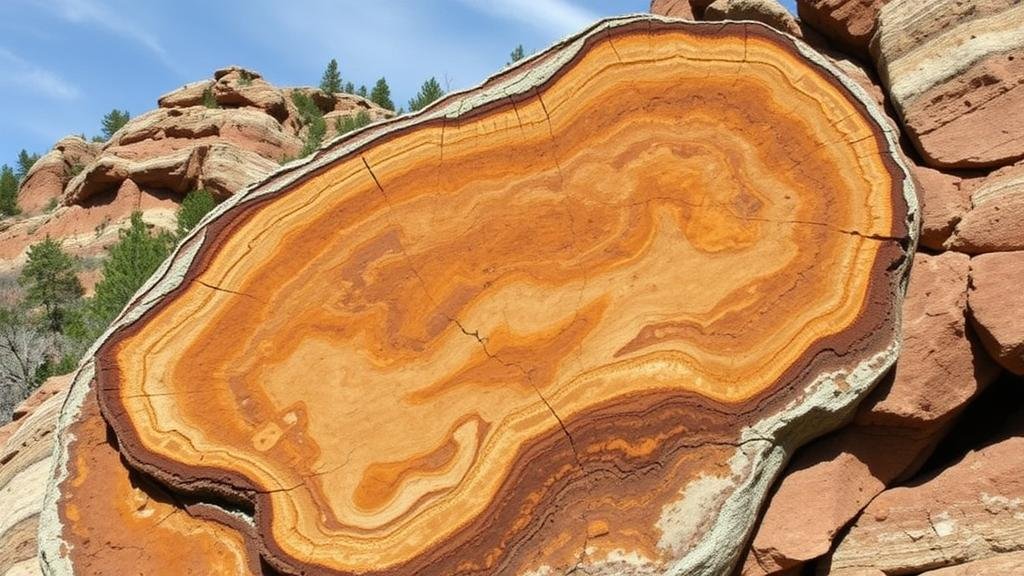Petrified Wood: Tracing Prehistoric Forests in Rocky Outcrops
Petrified Wood: Tracing Prehistoric Forests in Rocky Outcrops
Petrified wood, a captivating geological wonder, serves as a window into the ancient forests that flourished millions of years ago. This unique form of fossilization, where organic materials have been replaced by minerals, creates stunning specimens that attract rockhounds and mineral collectors alike. Understanding the formation process, types, and locations of petrified wood can greatly enhance the collecting experience.
Understanding the Formation of Petrified Wood
To comprehend petrified wood, one must appreciate the intricate geological processes involved. When trees die and fall, they are often buried by sediment in riverbeds or volcanic ash. Over time, these layers prevent decay, creating an anaerobic environment. Mineral-rich water seeps through these layers, gradually replacing the organic material with minerals such as silica, calcite, or pyrite.
The transformation from wood to stone can take millions of years, during which the trees cellular structure and rings are preserved. This preservation allows collectors to trace the age and type of the tree, adding depth to their collections. For example, tree rings can provide insights into prehistoric climatic conditions.
Varieties of Petrified Wood
Petrified wood comes in various types, each exhibiting distinct patterns and colors due to the minerals involved in its formation. Below are some notable varieties:
- Agatized Wood: Characterized by vibrant hues, this type contains agate and shows varied colors like pinks and greens.
- Opalized Wood: This type showcases iridescent patterns and colors due to the presence of opal within the wood.
- Calcified Wood: Typically more muted in color, calcified specimens can reveal unique textures and structural details.
Each variety presents unique characteristics that can enhance a collection and serve as a conversation starter among enthusiasts.
Collecting Petrified Wood: Practical Tips
For aspiring collectors, locating and identifying petrified wood can prove challenging yet rewarding. Here are actionable tips to aid in the process:
- Research Locations: Many regions across the United States, such as the Petrified Forest National Park in Arizona, are famous for their rich deposits. Other noteworthy sites include the John Day Fossil Beds in Oregon and deposits found across the Badlands in South Dakota.
- Look for Indicators: When searching for petrified wood, be on the lookout for unusual shapes, textures, and colors that resemble wood. Fractures may reveal glimpses of the woods cellular structure.
- Review Local Regulations: Always check for collecting regulations in your chosen area. Some sites may not permit collecting, while others may have restrictions on the volume or method.
Preserving Petrified Wood
Once you have collected petrified wood specimens, it is essential to properly preserve them to maintain their integrity and beauty. Here are some preservation methods:
- Avoid Excessive Moisture: Store petrified wood in a dry environment to prevent any potential deterioration. Consider using silica gel packets in storage containers to absorb humidity.
- Limit Sun Exposure: Prolonged exposure to sunlight can cause the colors to fade. Displaying your collection in shaded areas or using UV-protective glass can mitigate this issue.
- Regular Cleaning: Gently clean the specimens with a soft brush to remove dust and debris. Avoid chemical cleaners that can damage the wood.
Real-World Applications of Petrified Wood
Beyond its aesthetic value, petrified wood has practical applications. Artisans often craft stunning jewelry, sculptures, and decorative items from polished specimens. Also, petrified wood is utilized in scientific research to study past climates and ecological conditions.
For example, researchers have utilized the growth rings of petrified wood to understand the climate of the ancient environment in which the trees thrived. This information is invaluable for paleoclimatology and can offer insights into climate change patterns.
Conclusion: The Allure of Petrified Wood
Petrified wood offers an extraordinary glimpse into prehistoric life, making it a treasured subject for collectors and rockhounds. From understanding its unique formation process and varieties to practical collecting tips and applications, enthusiasts can find endless ways to engage with this remarkable geological artifact. By following these guidelines, collectors can not only build a meaningful collection but also contribute to the appreciation and protection of these ancient treasures.


